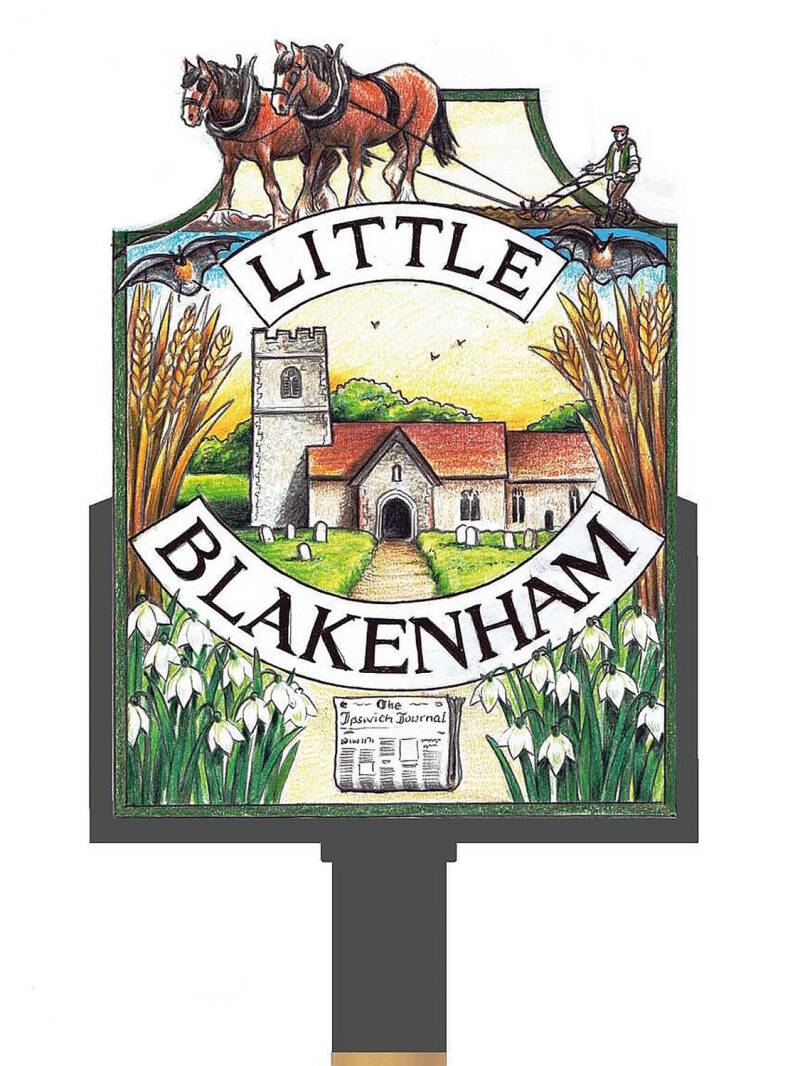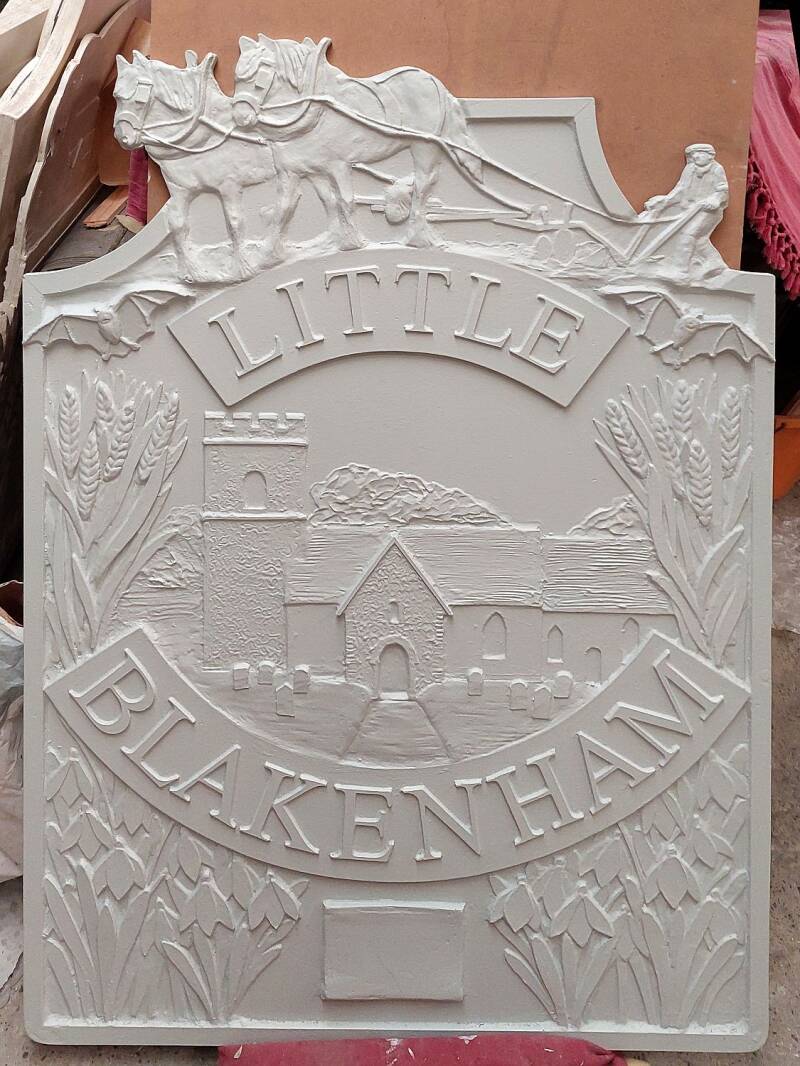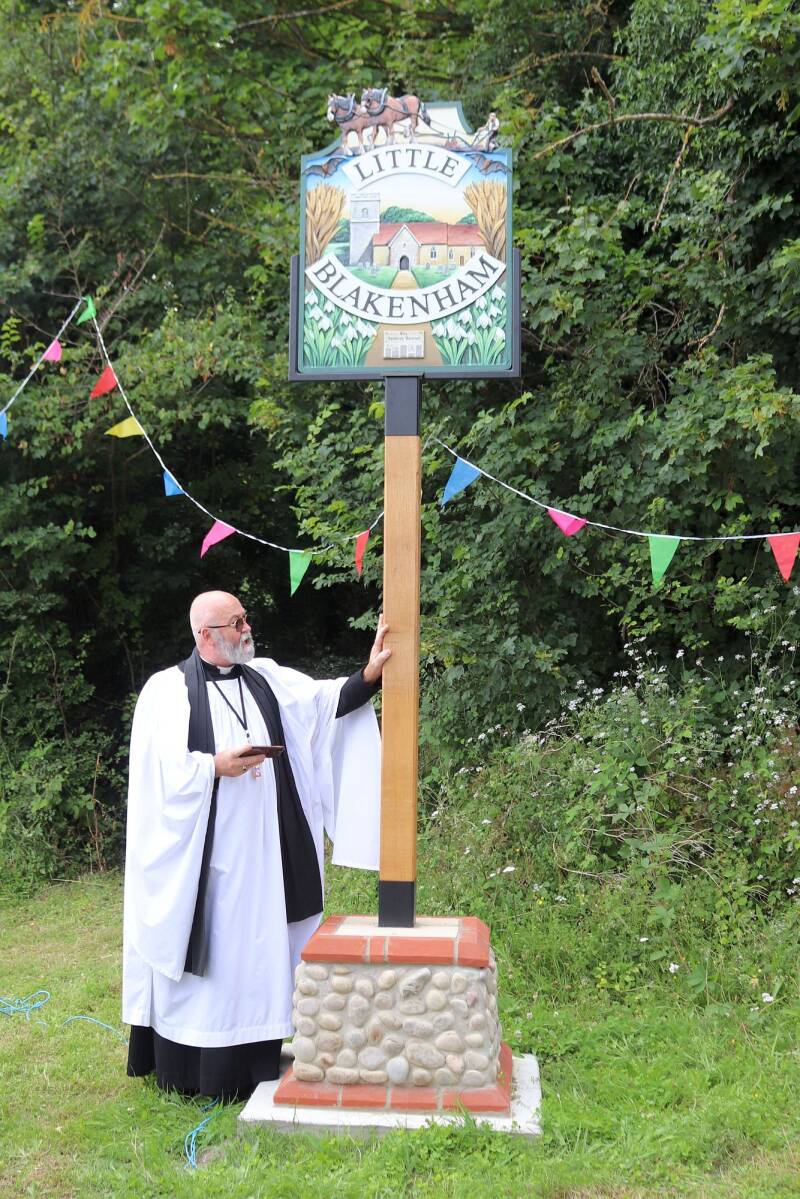Little Blakenham
The Sign (Text by Michele Kenningale and Bob Mitchell)
Pre-requisites:
The parish council were first approached by resident and village history recorder Michele Kenningale in July 2021 with the proposal to erect a village sign to mark Queen Elizabeth’s II Platinum Jubilee year. Sadly, following Queen Elizabeth II’s death the aim changed to mark Kings Charles III accession to the throne, unfortunately this timeline also lapsed, and the village sign was eventually unveiled Sunday 21st July 2024. Funding was achieved through generous grants from the County Councillor Chris Chambers, District Councillor John Field, and a generous private donation from a local resident. Using research and local knowledge Michele made a draft of possible elements to be included in the sign and once agreed in partnership with the parish council these were sent to the Village Sign People who drafted two pencil designs. These designs were then taken to a parish council meeting and the final design chosen and The Village Sign People commissioned.
Acknowledgements:
Many thanks go to Chris Chambers, John Field and the private donator who all supported the project financially so generously. Special thanks go to local builder and parish councillor Barry Palmer, who kindly donated both his time and materials for the base, plinth and erected the sign.
I am also grateful to local resident and parish councillor John Latham for his support, knowledge and kind permission to incorporate his horse and plough signage into the sign.
To Bob Mitchell of the Village Sign Society for attending today, and for his work recording village signs, to now include ours, on this website.
Finally, to the parish council for supporting the project, paying for the street licence required, and to our parish clerk Jennie Blackburn for all her assistance obtaining the planning permissions and licences required.
Positioning of the sign:
This was a difficult decision, as we have no village green and the village is dispersed into distinct areas over the parish. The Common stretches alongside the B1113 and is some distance from what can be described as the main settlement situated on and around the Somersham and Valley Roads.
It was agreed that the sign needed to be a prominent feature of the village, and a piece of land at the junction of Somersham and Valley Road identified, and planning permission applied for and granted.
Unveiling of the Village Sign
The sign was unveiled to a large audience from the village with an excellent buffet afterwards in the village hall. The sign was unveiled by Marcia Blakenham, the second Viscountess Blakenham, with help from Barry Palmer, Michele Kenningale and the vicar, Revd. Eric Falla. The Vicar also blessed the sign and the future health and well being of the village.
Start to finish:
The designs above are protected under the Copyright Designs and Patents Act 1988. All design content available from the Village Sign People or anyone sub-contracted by them is copyright. It is forbidden to alter or adapt the content of any graphics work, art work, pencil drawings or otherwise, without their express permission. It is forbidden to sell, license, copy or reproduce any graphics in whole or part, in any manner, for commercial purposes, without their prior written consent.
Sign Details:
Ploughman and Horses
At the top of the sign is a Ploughman with two heavy horses, depicting the village’s agricultural heritage and a time prior to agricultural tension as mechanisation and industrialisation grew. A time when Agricultural Associations were formed to help the farmer and ploughing competitions with cash prizes in an attempt retain labourers on the land. Farmers were unable to compete with the wages being offered by the developing commercial ventures such as the brick, lime and cement industry which played such a large role in the village due to the lime, chalk and clay resources found here, the remnants of which can still be seen today embedded in the village landscape.
St Mary the Virgin Church
Central to the sign is the village Grade I listed Church of St Mary the Virgin. There has been a church on the present site since the 12th century and today the main structure of the church dates to the 14th century.
The church has had several well-read and characterful Rectors over its time, some resident clergy and some not, who employed curates. One such Rector was Rev George Capper (1767-1847), Rector of Gosbeck and Little Blakenham and Vicar of Wherstead where he lived. Rev Capper’s curate here was Stephen Jackson (1785-1838), and on 13th May 1815 Rev Cappers appointment at Little Blakenham ceased, deemed void by Secession.
Lionel Henry Moore of Nettlestead Hall had held the Manor alongside the advowson of Nettlestead Church and Little Blakenham Rectory. Stephen’s father also Stephen Jackson (1747-1818) proprietor and editor of the Ipswich Journal had bought the Patronage and Advowson from Moore sometime prior to December 6th 1815 when his son Stephen was instituted here.
When Stephen (1747-1818) died his Will bequeathed to his eldest son Postle (1778-1847), property and land in St Lawrence, St Clements in Ipswich, Little Blakenham and Bramford and ‘half the business, all property rights, machinery, printing materials and profits from them for his sole use alongside the ‘advowson donation free disposition Right of Patronage and Presentation of in and to the Rectory of Little Blakenham and Parish Church of Nettlestead’.
Second son Rev. Stephen (1785-1838) inherited property and land in St Mary at the Elms Ipswich, St Mary Stoke, his father’s gold watch and all his furniture, linen and china. Rev Stephen, Rector of Nettlestead Church since 1815, and living at Little Blakenham Rectory, died there on 4th January 1838 and is buried in the Jackson family vault at Nettlestead.
Following Postle Jackson’s death in 1847, his eldest son another Stephen Jackson (1807-1855) became Rector of both parishes, and inherited further property, land and the business of the The Ipswich Journal, alongside the patronage and advowson of both churches. Rev. Stephen’s brother Rev John Jackson (1813-1895) became his curate and Rector in 1837 and remained here until his death in 1895, carrying out the church’s last major restoration in 1868 at a cost of £300.
Rev. John Jackson contributed £90 and the Churchwarden Mr George Josselyn at The Red House, contributed £50. It was reported in The Ipswich Journal, that ‘other inhabitants of the parish contributed liberally, and about £67 was raised by a Church-rate rise’ which caused uproar from the farmers, landowners and occupiers in the village, Rev John Jackson was obviously a canny man as the following year church rates were abolished. Rev John Jackson appears to have been a devoted Rector to this parish. A newspaper article in 1894, a year before his death, stated that at age 80 he had been Rector for over fifty years and was still of sound mind, still taking two entire services each Sunday and had never ministered to any other parishes, he too is buried in the family vault at Nettlestead.
The Ipswich Journal Newspaper
The Ipswich Journal was originally founded in August 1720 by John Bagnall who had moved from London to Ipswich. In 1739, William Craighton (1706-1761) an established bookseller in Ipswich, from around 1721 became the proprietor and editor of the weekly newspaper and it is presumed also the printing office in St Mary at the Elms as nothing else is heard of Bagnall.
The Jackson family were related to the Craighton family, through William Craighton’s sister Sarah, who married John Jackson in 1738 at Rushmere St Andrew.
When William Craighton died in 1761, an announcement in the paper stated that the Paper and Printing business would be carried on by William’s sister Elizabeth Craighton (1704-1796) and nephew William Jackson (1744-1774). However, William and Elizabeth’s partnership was dissolved on August 28th 1769 when Elizabeth was informed by William’s creditors that they were unable to pay her the £20 annuity as agreed in consideration of her interest in the newspaper.
John Shave, an Ipswich publisher and bookseller, first heard of in 1764, had obtained a printing press, and assisted Elizabeth, who called in another nephew, William’s brother, Stephen Jackson (1747-1818) as editor, after serving his apprenticeship with Henry Woodfall, proprietor of the Public Advertiser and the business continued at John Shave's printing premises at the corner of King Street, Ipswich.
Elizabeth Craighton died in 1796 at the grand age of 92 years, and Stephen inherited property, lands and the newspaper business. In 1798 Stephen parted company with John Shave and moved the business to new premises at the top of Old Goal Lane in the Buttermarket, Ipswich.
Stephen Jackson (1747-1818) now Proprietor and editor of The Ipswich Journal married Elizabeth Postle (1744-1816) in 1777, they had two sons, Postle (1778-1847) and Stephen (1785-1838). When Stephen died in 1818, he had been proprietor and editor of the Ipswich Journal for 43 years and acquired much property and land both in Ipswich and nearby parishes including the advowson of Nettlestead and Little Blakenham Rectory which he had purchased from Lionel Henry Moore of Nettlestead Hall.
Stephen’s eldest son Postle Jackson (1778-1847) married Sarah Burcham (1781-1862), and they had seven children, three of their son’s Stephen (1807-1855) John (1813-1895) and George (1816-1876) all became clergymen.
Stephen (1807-1855) eldest son of Postle, alongside being a clergyman, succeeded his father as Proprietor and Co Editor of the “Ipswich Journal” and married Catharine Cobbold on 27th April 1854 tragically, on February 16th 1855, The newspaper reported, Stephen was seized with ‘a fatal attack of “paralysis” whilst walking in Elm Street Ipswich’ and died the same day at the age of 47, Catharine was three months pregnant.
Following Stephen’s death in 1855, the Ipswich Journal was managed by Trustees for the Jackson family and the final issue was published on 26th July 1902 when it was taken over by The East Anglian Daily Times.
Bats
As mentioned previously, the village landscape still reflects today the heritage of both its agricultural and industrial past, through the large, excavated chalk pits. One of the village pits is now a Site of Special Scientific Interest and contains a 127-metre-long tunnel which still houses the original lime kiln but also the largest hibernating underground bat roost in Great Britain with approximately 450 bats.
Snowdrops
Blakenham Woodland Garden, is a combination of a traditional woodland garden and exotic trees, shrubs and flowers. When Michael and Marcia Hare (2nd Viscount and Viscountess Blakenham) moved here in 1982 there were only two small patches of snowdrops which they divided and replanted and now in spring the garden reflects a profusion of snowdrops, many are from the original division and other varieties which have been donated. The Garden is now a charitable trust and part of the National Garden Scheme.
Wheat
Simply, to represent the village’s part in the grain growing county of Suffolk.
The Name and Population
The village has been known by several name variations over the centuries, The Domesday Book, 1086 records the village as a settlement named Blacham, and through the following centuries as Blakenham-on-the-Hill, Blakenham Super Montem (St. Mary), and Blakenham Parva interpreted today as Little Blakenham. The population was recorded as 295 at the 2011 census.
A very local gathering for the village sign unveiling and blessing by the local vicar
Little Blakenham St Mary the Virgin









